
table of contents
- Buzzards (buteo)
- Real eagle (Aquila)
- Osprey (Pandion)
- Hawks and sparrowhawks (Accipitridae)
- Kites (milvus)
- White-tailed eagle (Haliaeetus)
- Consecration (circus)
- Special case: falcons (Falco)
- frequently asked Questions
Birds of prey fascinate with their impressive flying skills and hunting techniques. However, since they are rarely seen today, it is difficult to determine. So-called flight images are a useful aid.
In a nutshell
- Identify birds of prey even at great heights with flight images
- Wings (wings) and tail (thrust) serve as recognition features
- various flight characteristics (gliding, sailing, shaking, etc.) are further criteria
Buzzards (buteo)
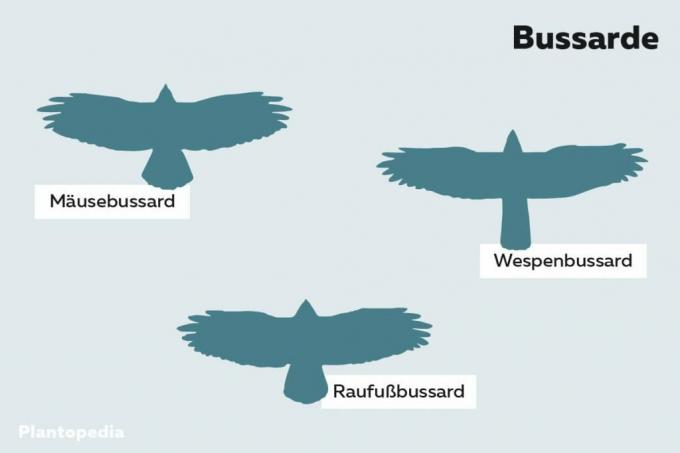
Common buzzard (Buteo buteo)
- broad, fingered wings
- Tail: short, banded, mostly diversified
- retracted head
- Glider flight: wings raised in a V-shape, wing tips curved upwards
- Wingspan: 113 to 128 centimeters
- Body length: a good 50 centimeters
- Habitat: breeds in the forest; hunts in open terrain (wooded landscapes with pastures, meadows, fields and pond landscapes)
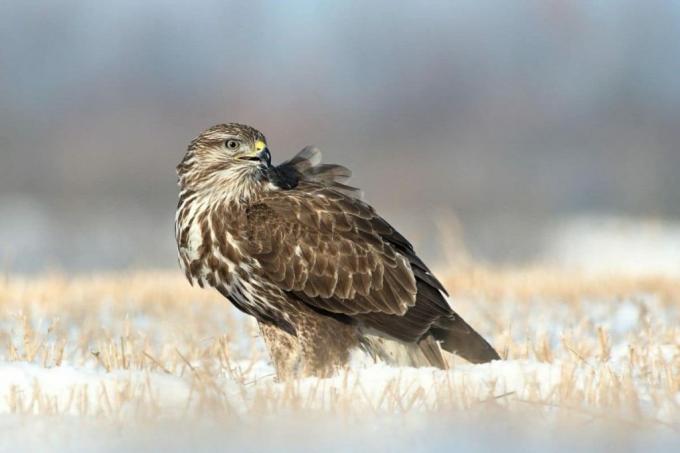
Greater Buzzard (Buteo lagopus)
- light, almost whitish head
- hardly any difference to the common buzzard
- shakes often (shaking flight = remaining in flight in one position, comparable to a hummingbird)
- Wingspan: 120 to 150 centimeters
- Body length: 50 to 60 centimeters
- Habitat: here migrants or winter visitors (regularly in Schleswig-Holstein), open and spacious terrain
Honey buzzard (Pernis apivorus)
Although the honey buzzard is not directly related to the common buzzard, it is often compared to it. Therefore, its flight image is described at this point.
- elongated head and straight wings, much slimmer than common buzzard
- Tail significantly longer and narrower than that of the common buzzard
- Head somewhat slimmer and more protruding than that of the common buzzard
- Wingspan: 135 to 150 centimeters
- Body length: about 55 centimeters
- Habitat: varied landscapes (mixture of forests, bushes, meadows and cultural steppes), larger park landscapes, preferably the proximity of water
Real eagle (Aquila)

Lesser Spotted Eagle (Aquila pomarina, Syn.: Clanga pomarina)
- Typical flight: smooth gliding flight with bowed head
- broad, board-like wings with a horizontal flight position
- Wings of the hand with strong fingers
- Wingspan: 146 to 168 centimeters
- Body length: up to 66 centimeters (slightly larger than a common buzzard)
- Habitat: Forests with adjacent, open areas; humid lowlands with deciduous and mixed forests on the border with moors and wet meadows
Golden eagle (Aquila chrysaetos)
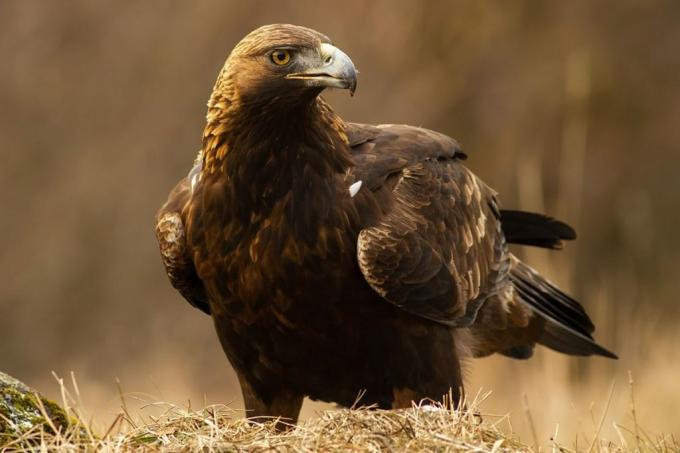
- slim flight image
- very long and wide wings
- medium-length tail
- Wings held almost horizontally
- Wings of the hand with noticeable fingering
- Strongly protruding head
- Wingspan: 204 to 220 centimeters (second largest bird of prey in Europe)
- Body length: 75 to 95 centimeters
- Habitat: valley slopes and mountain flanks in the Alps; mostly hunts above the tree line in summer; in Central Europe only breeds in the Alpine region
Osprey (Pandion)
Osprey (Pandion haliaetus)
- long, narrow, mostly angled wings
- dazzling white underside
- Wingspan: 145 to 170 centimeters
- Body length: up to about 60 centimeters
- Habitat: open and clear waters (high tree population to the eyrie), wooded lake areas, floodplains, coasts
Hawks and sparrowhawks (Accipitridae)

Goshawk (Accipiter gentilis)
- short, rounded, broad wings
- long, clearly rounded and broadly banded tail
- often longer gliding phases in flight
- Wingspan: 135 to 165 centimeters
- Body length: 48 to 62 centimeters (females significantly larger than males)
- Habitat: Plains, in the mountains up to 1,500 meters above sea level, varied landscapes with a high proportion of deciduous, mixed and / or coniferous forests
Sparrowhawk (Accipiter nisus)

- rounded, wide wings (round wings)
- long tail rounded at the corners
- Wingspan: 55 to 70 centimeters
- Body length: 28 to 37 centimeters (females significantly larger than males)
- Habitat: varied landscapes with a high proportion of forest, small forests in open terrain
Kites (milvus)

Red kite (Milvus milvus)
- Synonyms: red kite, fork consecration, royal consecration
- larger and longer wings than black kite
- five fingers on the wing tips
- bright manual vibration field
- longer tail, also with deeper fork than black kite
- Wingspan: 175 to 195 centimeters
- Body length: about 65 centimeters
- Habitat: varied landscapes (forests and open spaces)
Note: The red kite has become very rare in Central Europe. In the Alps and the northern foothills of the Alps, as well as in parts of Lower Saxony and Schleswig-Holstein, it is absent as a breeding bird, but partly overwinters in this country.
Black kite (Milvus migrans)

- Synonyms: Black Milan
- long wings, six fingers on the tips of the wings
- long, weakly forked tail (often referred to as "straight")
- Wingspan: 160 to 180 centimeters
- Body length: about 57 centimeters
- Habitat: breeds in forests, larger field trees, near water or reed landscapes (often in the vicinity of heron colonies); prefers near water outside of the breeding season
White-tailed eagle (Haliaeetus)
White-tailed eagle (Haliaeetus albicilla)
- broad and board-shaped wings
- Tail: short and wedge-shaped in the adult bird, longer and rounder in the young bird
- noticeably large head
- Wingspan: 200 to 240/250 centimeters (largest bird of prey in Europe)
- Body length: 70 to 95 centimeters
- Habitat: near lakes, rivers, sea coasts; Horst in old wood or at the edge of the forest (tall trees)
Consecration (circus)
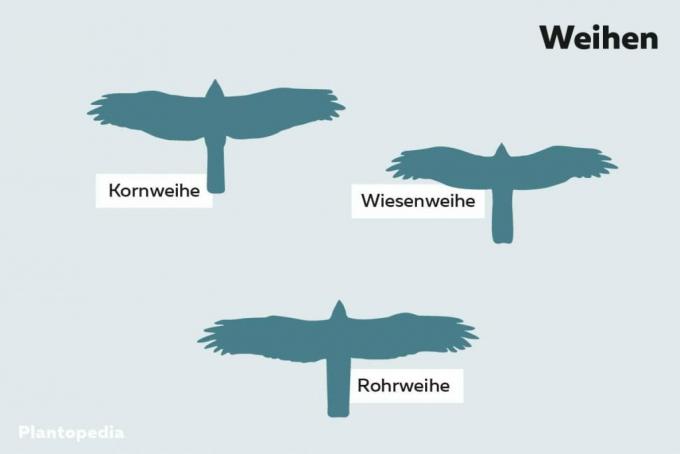
Hen harrier (Circus cyaneus)
- narrow wings
- long tail
- Gliding and gliding: wings raised in a V-shape
- Wingspan: 100 to 120 centimeters
- Body length: up to 50 centimeters
- Habitat: Fields, bogs and meadows in the plain, heathland areas, lowlands with bodies of water
Marsh harrier (Circus aeruginosus)
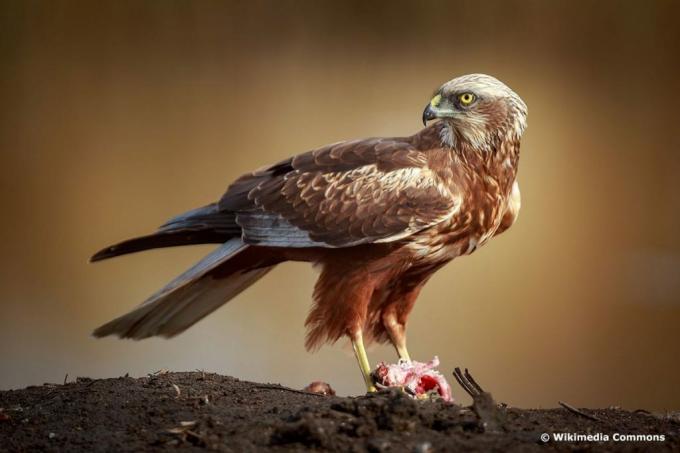
- narrow, long wings
- long tail
- Gliding and gliding: wings raised in a V-shape
- Wingspan: 115 to 130 centimeters
- Body length: 48 to 56 centimeters
- Habitat: open landscapes with bodies of water and extensive reed areas, swamps, in Germany especially in Schleswig-Holstein and Lower Saxony
Montagu's Harrier (Circus pygargus)
- typical flight: jiggling, seagull-like
- long tail and narrow, long wings
- narrower wings than hen harrier
- Gliding and gliding: wings raised in a V-shape
- Wingspan: 105 to 120 centimeters
- Body length: 43 to 47 centimeters
- Habitat: moist lowlands, river valleys, raised and flat moors, transitional moors
Special case: falcons (Falco)
Although belong Hawks Due to the latest DNA analyzes, no longer part of the order of the birds of prey, but since they are generally referred to as such, the most important representatives are still listed here.
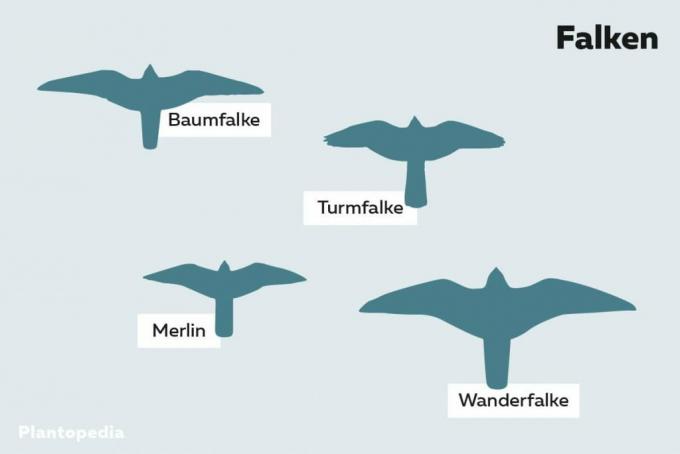
Tree falcon (Falco subbuteo)
- faster manoeuvrable flight
- high impact frequency
- only short gliding distances
- rarely shakes
- very long, sickle-shaped wings
- Tail shorter than that of the kestrel
- Wingspan: 82 to 92 centimeters
- Body length: 30 to 36 centimeters
- Habitat: deciduous and coniferous forests, open terrain with trees
Tip: The flight pattern of the tree hawk is reminiscent of that of the common swift.
Merlin (Falco columbarius)
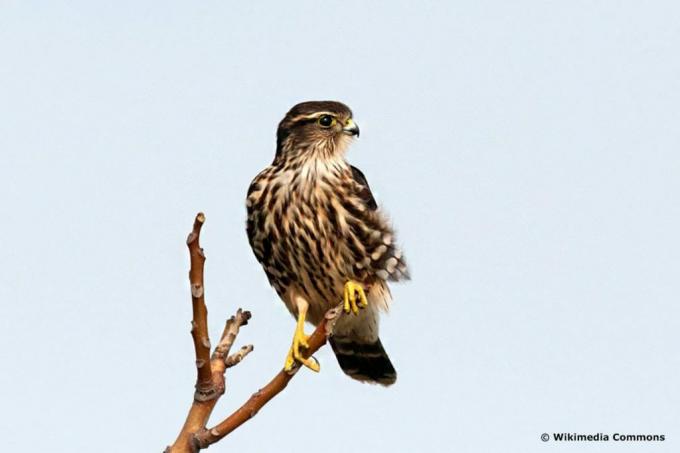
- broad-winged and stocky flight image
- fast and straight flight; rapid wing beats, only short glide phases
- pointed wings, but wider than falcon
- Tail shorter than that of the kestrel and with a broader band at the end
- Wingspan: 50 to 62 centimeters
- Body length: 25 to 30 centimeters
- Habitat: in this country at migration time and in winter, open terrain
- Note: The Merlin is the smallest falcon in Europe.
Kestrel (Falco tinnunculus)
- typical flight: shaking flight
- long, pointed wings
- long tail
- Wingspan: 50 to 60 centimeters
- Body length: up to 35 centimeters
- Habitat: open landscapes with groups of trees, rocky terrain, forest edges, closed villages, industrial areas, wastelands
Note: The kestrel is the most common falcon in the cultural landscape.
Peregrine falcon (Falco peregrinus)

- long, pointed wings
- short, pointed tail
- fast, powerful wing beats
- Wingspan: 95 to 110 centimeters
- Body length: 36 to 48 centimeters (males significantly smaller than females)
- Habitat (breeding grounds): mountains, flatlands, on coasts, on islands
frequently asked Questions
A finger cannot be seen in the flight of falcons.
The tail is meant by thrust. The name comes from the hunter's language and is also used to describe the flight image.

